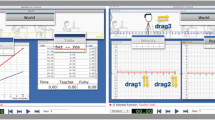Abstract
We analyze the intersection of new forms of representation infrastructures in SimCalc MathWorlds® with the affordances of available communication infrastructures. We describe the fundamental design principles from a software and curriculum perspective of why these two infrastructures can be overlapped in educational environments for important and meaningful learning outcomes. The products of this intersection result in new modes of expression (in terms of gesture, deixis and informal/formal registers), classroom identity formation in mathematically meaningful ways, and pedagogy in terms of activity structure and intentionality.
This work is based upon work supported by the National Science Foundation under grant REC-0337710 and the Institute of Education Sciences at the US Department of Education under grant R305B070430. Any opinions, findings, and conclusions or recommendations expressed in this material are those of the author(s) and do not necessarily reflect the views of these agencies.
Originally published in ZDM: The International Journal in Mathematics Education. doi:10.1007/s11858-009-0191-7.
Access this chapter
Tax calculation will be finalised at checkout
Purchases are for personal use only
Similar content being viewed by others
Notes
- 1.
By affordance we mean a quality of an object, or an environment, that allows an individual to perform an action. We thank one of our reviewers for offering us a succinct and meaningful definition.
References
Bakhtin, M. M. (1981) The dialogic imagination: four essays (trans: Emerson, & C., Holquist, M.). Austin: University of Texas Press.
Bransford, J. D., Brown, A. L., & Cocking, R. R. (Eds.) (2000). How people learn: brain, mind, experience, and school: expanded edition. Washington: National Academy Press.
Burke, K. A. (1969). A grammar of motives. Berkeley: University of California Press.
Deacon, T. (1997). The symbolic species: the co-evolution of language and the human brain. New York: Norton.
Donald, M. (2001). A mind so rare: the development of human consciousness. New York: Norton.
Duranti, A. (1997). Linguistic anthropology. Cambridge: Cambridge University Press.
Eckert, P. (1989). Jocks and burnouts: social categories and identity in the high school. New York: Teachers College Press.
Gee, J. P. (1999). Social linguistics and literacies: ideology in discourse (2nd ed.). New York: Taylor and Francis.
Hegedus, S., Dalton, S., Cambridge, L., & Davis, G. (2006). Patterns of participation in networked classrooms. In J. Novotna, H. Moraova, M. Kratka, & N. Stehlikova (Eds.), Proceedings of the 30th conference of the international group for the psychology of mathematics education (Vol. 3, pp. 257–264). Prague, Czech Republic: Program Committee.
Hegedus, S., & Penuel, W. (2008). Studying new forms of participation and identity in mathematics classrooms with integrated communication and representational infrastructures. Special Issue of Educational Studies in Mathematics: Democratizing Access to Mathematics Through Technology—Issues of Design and Implementation, 68(2), 171–183.
Huffaker, D. A., & Calvert, S. L. (2003). The new sciences of learning: active learning, metacognition, and transfer of knowledge in e-learning applications. Journal of Educational Computing Research, 29(3), 325–334.
Kaput, J. (1991). Notations and representations as mediators of constructive processes. In E. von Glasersfeld (Ed.), Radical constructivism and mathematics education (pp. 53–74). Boston: Reidel.
Penuel, W. R., & Wertsch, J. V. (1995). Dynamics of negation in the identity politics of cultural other and cultural self. Culture and Psychology, 1(3), 343–359.
Resnick, M., Berg, R., & Eisenberg, M. (2000). Beyond black boxes: bringing transparency and aesthetics back to scientific investigation. Journal of the Learning Sciences, 9(1), 7–30.
Shaffer, D. W., & Kaput, J. J. (1999). Mathematics and virtual culture: an evolutionary perspective on technology and mathematics education. Educational Studies in Mathematics, 37(2), 97–199.
Stroup, W. (2003). Understanding qualitative calculus: a structural synthesis of learning research. International Journal of Computers for Mathematical Learning, 7(2), 167–215.
Wilensky, U., & Resnick, M. (1999). Thinking in levels: a dynamic systems approach to making sense of the world. Journal of Science Education and Technology, 8(1), 3–19.
Wilensky, U., & Stroup, W. (1999). Learning through participatory simulations: network-based design for systems learning in classrooms. Paper presented at the Computer Supported Collaborative Learning (CSCL ’99) conference, Stanford University, 12–15 December, 1999.
Wilensky, U., & Stroup, W. (2000). Networked gridlock: students enacting complex dynamic phenomena with the HubNet architecture. In Proceedings of the fourth annual international conference of the learning sciences, Ann Arbor, MI.
Wortham, S. (2004). The interdependence of social identification and learning. American Educational Research Journal, 41(3), 715–749.
Author information
Authors and Affiliations
Corresponding author
Editor information
Editors and Affiliations
Rights and permissions
Copyright information
© 2013 Springer Science+Business Media Dordrecht
About this chapter
Cite this chapter
Hegedus, S., Moreno-Armella, L. (2013). Intersecting Representation and Communication Infrastructures. In: Hegedus, S., Roschelle, J. (eds) The SimCalc Vision and Contributions. Advances in Mathematics Education. Springer, Dordrecht. https://doi.org/10.1007/978-94-007-5696-0_4
Download citation
DOI: https://doi.org/10.1007/978-94-007-5696-0_4
Publisher Name: Springer, Dordrecht
Print ISBN: 978-94-007-5695-3
Online ISBN: 978-94-007-5696-0
eBook Packages: Mathematics and StatisticsMathematics and Statistics (R0)




